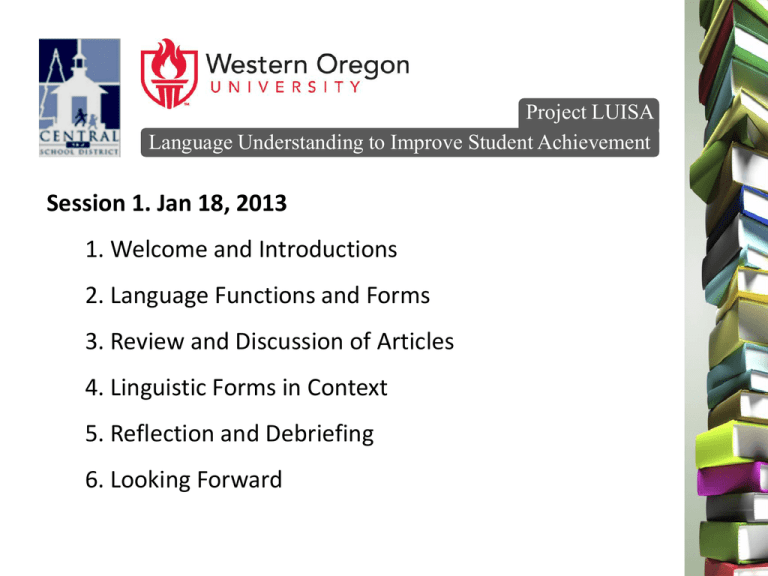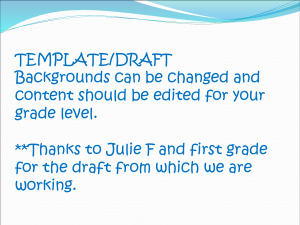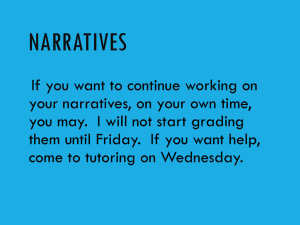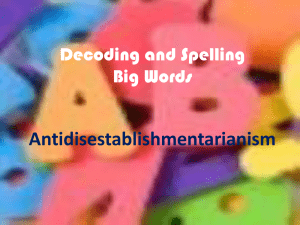ppt - WOU & Central School District
advertisement

Project LUISA Language Understanding to Improve Student Achievement Session 1. Jan 18, 2013 1. Welcome and Introductions 2. Language Functions and Forms 3. Review and Discussion of Articles 4. Linguistic Forms in Context 5. Reflection and Debriefing 6. Looking Forward Common ELL errors Elements of the system of language •Phonology: the study of the sounds of a language •Morphology: the study of words and parts of words •Syntax: the study of the structure of sentences and the rules that govern the formation of a sentence •Semantics: the study of meanings of individual words and of larger units such as phrases and sentences •Pragmatics: the study of language use in context Language Functions refer create songs, poems, stories, jokes to things and information ask for information narrate ask for clarification persuade ask for agreement inform interpret express interact describe request emotions socially evaluate offer and summarize paraphrase opinions generalize summon thank introduce forgive greet predict direct apologize conclude hypothesize advise congratulate refuse warn metalingual complain to discuss and threaten complement describe language Which Functions do we need to teach? refer create songs, poems, stories, jokes to things and information ask for information narrate ask for clarification persuade ask for agreement inform interpret express interact describe request emotions socially evaluate offer and summarize paraphrase opinions generalize summon thank introduce forgive greet predict direct apologize conclude hypothesize advise congratulate refuse warn metalingual complain to discuss and threaten complement describe language Language Functions (in school) ODE requirements Asking informational questions clarifying questions Giving Information Expressing needs and likes Expressing and supporting opinions Retelling/relating past events Literary analysis Persuading Describing people, places, things Describing spatial and temporal relations Describing actions Sequencing Defining Explaining Generalizing Summarizing Comparing Contrasting Cause and effect Interpreting Evaluating Drawing conclusions Making predictions Hypothesizing and speculating Language Functions and Forms (in school) Certainfunction What Forms are stands likely out toinoccur this passage? with a given Function Describing people, places, things On sultry summer days at my grandma’s farm in Michigan, the air gets damp and heavy. Storm clouds drift low over the fields. Birds fly close to the ground. The clouds glow for an instant with a sharp crackling light, and then a roaring, low, tumbling sound of thunder makes the windows shudder in their panes. from “Thunder Cake,” Literacy by Design, Grade 3 Language Functions and Forms (in school) Certain Forms are likely to occur with a given Function Describing people, places, things On sultry summer days at my grandma’s farm in Michigan, the air gets damp and heavy. Storm clouds drift low over the fields. Birds fly close to the ground. The clouds glow for an instant with a sharp crackling light, and then a roaring, low, tumbling sound of thunder makes the windows shudder in their panes. from “Thunder Cake,” Literacy by Design, Grade 3 Language Functions and Forms (in school) Certain Forms are likely to occur with a given Function Describing people, places, things On sultry summer days at my grandma’s farm in Michigan, the air gets damp and heavy. Storm clouds drift low over the fields. Birds fly close to the ground. The clouds glow for an instant with a sharp crackling light, and then a roaring, low, tumbling sound of thunder makes the windows shudder in their panes. from “Thunder Cake,” Literacy by Design, Grade 3 Language Functions and Forms (in school) Certain Forms are likely to occur with a given Function Describing people, places, things On sultry summer days at my grandma’s farm in Michigan, the air gets damp and heavy. Storm clouds drift low over the fields. Birds fly close to the ground. The clouds glow for an instant with a sharp crackling light, and then a roaring, low, tumbling sound of thunder makes the windows shudder in their panes. from “Thunder Cake,” Literacy by Design, Grade 3 Language Functions and Forms (in school) Certain Forms are likely to occur with a given Function Describing people, places, things On sultry summer days at my grandma’s farm in Michigan, the air gets damp and heavy. Storm clouds drift low over the fields. Birds fly close to the ground. The clouds glow for an instant with a sharp crackling light, and then a roaring, low, tumbling sound of thunder makes the windows shudder in their panes. from “Thunder Cake,” Literacy by Design, Grade 3 Language Functions and Forms (in school) Certainfunction What Forms are stands likely out toinoccur this passage? with a given Function Sequencing Recycling paper involves collecting used paper, sorting it according to color and quality, and cleaning it to remove staples or other non-paper items. Then, the clean, sorted paper is wet down and beaten to loosen the fibers. The recycled fibers can be made into cardboard or newsprint or mixed with wood pulp to make higher-quality paper. from “How is Paper Made?” Literacy by Design, Grade 3 Language Functions and Forms (in school) Certainfunction What Forms are stands likely out toinoccur this passage? with a given Function Sequencing Recycling paper involves collecting used paper, sorting it according to color and quality, and cleaning it to remove staples or other non-paper items. Then, the clean, sorted paper is wet down and beaten to loosen the fibers. The recycled fibers can be made into cardboard or newsprint or mixed with wood pulp to make higher-quality paper. from “How is Paper Made?” Literacy by Design, Grade 3 Language Functions and Forms (in school) Certain Forms are likely to occur with a given Function Sequencing Recycling paper involves collecting used paper, sorting it according to color and quality, and cleaning it to remove staples or other non-paper items. Then, the clean, sorted paper is wet down and beaten to loosen the fibers. The recycled fibers can be made into cardboard or newsprint or mixed with wood pulp to make higher-quality paper. from “How is Paper Made?” Literacy by Design, Grade 3 Language Functions and Forms (in school) Certainfunction What Forms are stands likely out toinoccur this passage? with a given Function Retelling/relating past events They sat down at the table and the girl looked across at the hills on the dry side of the valley and the man looked at her and at the table. ‘You’ve got to realize,’ he said, ‘ that … Language Functions and Forms (in school) Certain Forms are likely to occur with a given Function Retelling/relating past events They sat down at the table and the girl looked across at the hills on the dry side of the valley and the man looked at her and at the table. ‘You’ve got to realize,’ he said, ‘ that … Language Functions and Forms (in school) Certain Forms may not always occur with a given Function Retelling/relating past events President Abraham Lincoln was taking a vote in a cabinet meeting on whether to sign the Emancipation Proclamation. All his cabinet secretaries vote nay, whereupon Lincoln raises his right hand and declares: ‘The ayes have it’. Language Functions and Forms (in school) Certain Forms may not always occur with a given Function Retelling/relating past events President Abraham Lincoln was taking a vote in a cabinet meeting on whether to sign the Emancipation Proclamation. All his cabinet secretaries vote nay, whereupon Lincoln raises his right hand and declares: ‘The ayes have it’. Language Functions and Forms (in school) Certain Forms may not always occur with a given Function Retelling/relating past events President Abraham Lincoln was taking a vote in a cabinet meeting on whether to sign the Emancipation Proclamation. All his cabinet secretaries vote nay, whereupon Lincoln raises his right hand and declares: ‘The ayes have it’. Language Functions and Forms (in school) It is likely that a text displays several functions in close proximity. Describing people, places, things Describing spatial and temporal relations Retelling/relating past events Describing actions Defining Explaining Drawing conclusions Making predictions Language Functions and Forms (for spring) Functions Describe Actions Compare & Contrast Describe People & Things Describe Places & Locations Give & Follow Directions Express Time Relationships & Duration Predict and Express Cause & Effect Explain Characteristics of People, Things, and Places Classify Sequence Summarize and Generalize Forms Verb Tenses Adverbs BE Verb Forms Prepositions Auxiliary Verbs Adjectives Imperatives Nouns Exclamations Pronouns Negation Conjunctions Adverb Clauses Adjective (Relative) Clauses Conditional Clauses Passive Voice There was/were/will be Clauses Figurative Language Idioms and Formulaic Phrases Antonyms Sharing Ideas/Concepts from articles read Group work. Read one of the articles and select three main ideas that you would like to share with your other peers. Key ideas to consider from Long (1997) Long gave three options of how language teaching can be done: a) Focus on forms b) Focus on meaning c) Focus on form He reviewed how language teaching was done traditionally. That is there was a predominance of forms as opposed to meaning. He then presented the meaning-focused lessons concept, where the objective was that students communicate (e.g., content-based lessons in sheltered subject matter) Students subconsciously learn the grammar provided with input (?) However, Long claims that teachers should focus on form as opposed to forms. A focus on form is a student-driven activity because it draws his/her attention to the linguistic elements needed in an appropriate context. He alludes to the pendulum swings (i.e., from incidental to non-incidental learning, from implicit to explicit teaching, from form to meaning). What do think of these swings? Key ideas to consider from Fillmore (2012) Text complexity for ELs and LM considered in the CCSS The role language plays when promoting literacy (e.g., not enough to teach isolated words -vocabulary) Language used in complex texts is different from ordinary talk (BICS & CALP ) or from spoken and written texts. Learning to read Reading to learn (e.g., social studies) Students have limited chances for interactions to learn academic language. “Academic language cannot be ‘taught’ [separately]” (p. 2). Fillmore (2012) Continued (?) Learn the language of literacy Explore literacy ELs and LM need to interact with complex texts Features of a complex text (e.g., informational density) Informational texts and expository prose requires elaborated nouns. Strategic approach suggested: One sentence at a time stemming from the students’ text. ELs and MS need to gain access to the ideas, concepts and information encoded in academic English. When ELs and MS notice how language is used, it is a step in the appropriate direction to “own” English. Form/Structure Meaning/Semantics Use/Pragmatics Key ideas to consider from Larsen-Freeman (2001) The meaning and use dimensions are added to the form concept communicative interactions. The interactive pie chart: The three-dimensional grammar framework (p. 252). It can also help to diagnose the kind of error. The three dimensions do not always have to be present in one lesson. The teacher prioritizes them depending on students’ needs. ELs need to master the three dimensions. Examples given: Possessive and phrasal verbs “Grammaring” is a needed skill to be developed. Larsen and Freeman (2001) continued The learning process (e.g., learning a structure at a time) The teaching process (e.g., The “PPP” approach, grammar outlined in advance, different from content-based materials) Let us promote “noticing” in what our students learn. Other strategies (e.g., recasting or enhancing the input) Let us provide focused-feedback. Keep a grammar checklist as opposed to following a grammar sequence. Focus on Form Forms to be focused on this spring Grammar: Appropriate words and word forms for the syntax Morphology Verb Tenses BE Verb Forms Nouns Adjectives Adverbs Syntax Auxiliary Verbs Negation Pronouns Conjunctions Imperatives Exclamations Adverb Clauses Passive Voice Adjective (Relative) Clauses Conditional Clauses There was/were/will be Clauses Figurative Language Idioms and Formulaic Phrases Antonyms Word Choice (Lexical Semantics) Morphology: the study of word formation What teachers should be aware of • inflectional morphemes (do not change PoS) in English, only suffixes • on nouns: plural marker (-s, -es), possessive (-’s, -s’) • on verbs: tense and aspect markers(-ed, -en, -ing) present tense, singular subject marker (-s) • on adj: degree markers (-er, -est) • derivational morphemes (change PoS and/or meaning) in English, prefixes and suffixes • re-, auto-, ex-, un-, dis-, mis-, co-, de-, pre-, in/im/ir/il-, etc • -er, -sion, -tion, -ist, -ful, -ness, -ity, -ly, -ment, etc. • root words and combinations Prefixes and Suffixes in ELL students’ writing Example Many student consideration how to choosing words but lacking sufficiently knowledgeable of vocabularies in contextual. Prefixes and Suffixes in ELL students’ writing Example Many students consider how to choose words but lack sufficient knowledgeable of vocabulary in context. Prefixes and Suffixes in ELL students’ writing Example Many students consideration how to choosing e words but lacking sufficiently knowledgeable . of vocabularies y in contextual. Inflectional affixes Derivational affixes -s, -ies (plurality) -ing (progressive) -ation (verb to noun) -ly (adjective to adverb) -able (noun to adjective) -ual (noun to adjective) -’s (possession) -s (3rd sing verb) -ed (past tense) -en (participle) -er, -est (adj degree) prefixes: un- (opposite), non- (not), etc., etc. Prefixes and Suffixes in ELL students’ writing Examples Some crimes, such as hi jack and rob are conducted using Airsoft guns. hijacking and robbery It accurately point_ that lots of farmlands losing is one factor which led to food lacking around the world. points out, farmland, loss, a lack of food (or food shortage) Prefixes and Suffixes in fiction/narrative At the edge of the market, I stopped. In a neat sparkling row stood several big new bicycles. One of them was decorated all over with red and blue. That’s what I would buy! For some time now, Murete, my father, had been teaching me to ride his big, heavy bicycle. If only I had a bicycle of my own. “My Rows and Piles of Coins” Literacy by Design, Grade 3 Prefixes and Suffixes in fiction/narrative At the edge of the market, I stopped. In a neat sparkling row stood several big new bicycles. One of them was decorated all over with red and blue. That’s what I would buy! For some time now, Murete, my father, had been teaching me to ride his big, heavy bicycle. If only I had a bicycle of my own. “My Rows and Piles of Coins” Literacy by Design, Grade 3 Prefixes and Suffixes in fiction/narrative At the edge of the market, I stopped. In a neat sparkling row stood several big new bicycles. One of them was decorated all over with red and blue. That’s what I would buy! For some time now, Murete, my father, had been teaching me to ride his big, heavy bicycle. If only I had a bicycle of my own. “My Rows and Piles of Coins” Literacy by Design, Grade 3 Prefixes and Suffixes in expository prose Trees are mostly a renewable resource: in theory, if some get cut down, others can be planted. But cutting down trees can be tragic. Clear-cutting, removing all the trees in an area, causes the soil to wash away. Trees can’t grow back on bare rock. Even if new trees are planted, the forest and its inhabitants may still die off. Sometimes only one type of tree is replanted. So, animals that need other types of trees for food or shelter can no longer live in the forest. “How is Paper Made?” Literacy by Design, Grade 3 Prefixes and Suffixes in expository prose Trees are mostly a renewable resource: in theory, if some get cut down, others can be planted. But cutting down trees can be v the trees in an area, causes the tragic. Clear-cutting, removing all soil to wash away. Trees can’t grow back on bare rock. Even if new trees are planted, the forest and its inhabitants may still die off. Sometimes only one type of tree is replanted. So, animals that need other types of trees for food or shelter can no longer live in the forest. “How is Paper Made?” Literacy by Design, Grade 3 Prefixes and Suffixes in expository prose Trees are mostly a renewable resource: in theory, if some get cut down, others can be planted. But cutting down trees can be v the trees in an area, causes the tragic. Clear-cutting, removing all soil to wash away. Trees can’t grow back on bare rock. Even if new trees are planted, the forest and its inhabitants may still die off. Sometimes only one type of tree is replanted. So, animals that need other types of trees for food or shelter can no longer live in the forest. “How is Paper Made?” Literacy by Design, Grade 3 Order of Acquisition of Grammatical Morphemes Native English speakers ELLs (of various L1s) present progressive –ing (mommy running) plural –s (two books) irregular past forms (baby went) possessive –’s (daddy’s hat) copula BE (Annie is happy) articles the and a regular past –ed (she walked) 3rd singular simple present -s (she runs) auxiliary BE (he is coming) present prog –ing plural –s copula BE auxiliary BE articles the and a irregular past forms regular past –ed 3rd singular present –s possessive –’s Brown and many others (1960s-70s) Krashen’s summary Verb Tenses Verb Tenses One way to conceptualize the English verb tense and aspect system is to use a timeline. X 15 years ago, I taught at Amity HS. X 7 years ago while I was living in Bangkok, Bangkok I completed my PhD. simple tenses Use an X for simple past, present, and future to represent a distinct time—it can be a specific event, or a longer “period” of time. progressive tenses Use an → for Ving forms to show their emphasis on ongoing or incomplete actions now ] ] By next fall, I will have lived in Monmouth for 6 years. By 2014 I will have been teaching for 20 years. perfect tenses perf-prog tenses Use ] for had/have/has+ ed/en forms to show their emphasis on completion of action Use →] for had/have/has+ been + -ing forms to show their emphasis on the ongoing action with completion Focus on Form Practice • Each table will receive copies of a passage from a 1st, 3rd, or 5th grade textbook. • At the top of the page we’ve indicated a function that is used in the text, a form that is present, and a page number in Azar and Hagen’s chartbook. 1. Refer to the chartbook first to review the form. 2. Read the passage and identify any examples of the form. 3. Discuss the following questions: a. How prominent/frequent is the form? b. How essential is the form to the meaning and function of the passage? c. What challenges might ELLs face when learning/acquiring this form? 4. If there is time, identify an additional form in the passage that could be used for teaching an ELL. Syntax: The internal structure of sentences What teachers should be aware of • sentence types declarative, question, imperative, exclamative • typical clause structures subject + verb + object subject + verb + adjective or noun subject + verb + adverbial modifier alternative structures (there + verb, it + verb, changed order) • conjunctions joining pieces inside phrases; joining clauses and sentences • noun modification premodifiers (adjective, noun, ed-participle, ing-participle) postmodifiers (prepositional phrase, relative clause, participle clause, appositive noun phrase) • adverbial modification prepositional phrase, single adverb, adverbial clause, participle or infinitive clause, noun phrase Everyday speech compared to written language in school “You need to put a weight on the bottom piece of thick paper so it doesn’t blow away.” A small counterweight needs to be placed on the bottom piece of card stock to act as a resisting force. Everyday speech compared to written language in school Vocabulary “You need to put a weight on the bottom piece of thick paper so it doesn’t blow away.” A small counterweight needs to be placed on the bottom piece of card stock to act as a resisting force. Everyday speech compared to written language in school Vocabulary “You need to put a weight on the bottom piece of thick paper so it doesn’t blow away.” A small counterweight needs to be placed on the bottom piece of card stock to act as a resisting force. Everyday speech compared to written language in school Everyday speech Formal writing Vocabulary Vocabulary most common verbs, nouns, content words specific to adjectives, adverbs the topic Information Density Short clauses Simple or compound sent. Verb-heavy Few noun modifiers Few verbal modifiers Information Density Longer clauses Complex sentences Noun-heavy Many noun modifiers Many verbal modifiers Everyday speech compared to written language in school Everyday speech 10 year-old native English speaker “You know, um, my friends Steven and Michael they’re twins and they always go fishing once a week and they’re going to have a birthday April second and so we’re going, um, fishing on a half-day boat.” Everyday speech compared to written language in school Everyday speech 10 year-old native English speaker—Clause analysis (40 words) You know, um, my friends Steven and Michael they’re twins (11) and they always go fishing once a week (8) and they’re going to have a birthday April second (10) and so we’re going, um, fishing on a half-day boat. (11) Everyday speech compared to written language in school Everyday speech 10 year-old native English speaker—noun modifiers, [adverbials] You know, um, my friends Steven and Michael they’re twins and they [always] go fishing [once a week] and they’re going to have a birthday [April second] and so we’re going, um, fishing [on a half-day boat]. Everyday speech compared to written language in school Non-Fiction from “Be My Neighbor.” Literacy by Design, Grade 1 Parks, plazas, streets, and backyards are all places to play in your community. If your neighborhood is near a lake, a river, or an ocean, you and your friends might go swimming, fishing, or boating. Swimming pools, ice rinks, sports fields, and playgrounds are places especially made for having fun. Everyday speech compared to written language in school Non-Fiction from “Be My Neighbor.” Literacy by Design, Grade 1 Parks, plazas, streets, and backyards are all places to play in your community. If your neighborhood is near a lake, a river, or an ocean, you and your friends might go swimming, fishing, or boating. Swimming pools, ice rinks, sports fields, and playgrounds are places especially made for having fun. Everyday speech compared to written language in school Fiction from The Black Stallion Alec wondered why the Black was being shipped to England. The slanting shoulders, the deep broad chest, the powerful legs, the knees not too high nor too low—these, his uncle had taught him, were marks of speed and endurance. Everyday speech compared to written language in school Fiction from The Black Stallion—clause analysis (40 words) Alec wondered [why the Black was being shipped to England]. The slanting shoulders, the deep broad chest, the powerful legs, the knees not too high nor too low—these, [his uncle had taught him], were marks of speed and endurance. Alec wondered [why the Black was being shipped to England]. The slanting shoulders, the deep broad chest, the powerful legs, the knees not too high nor too low—these, [his uncle had taught him], were marks of speed and endurance. His uncle had taught him that all these qualities were marks of speed and endurance. Everyday speech compared to written language in school Fiction from The Black Stallion—noun modifiers Alec wondered why the Black was being shipped to England. The slanting shoulders, the deep broad chest, the powerful legs, the knees not too high nor too low—these, his uncle had taught him, were marks of speed and endurance. Focus on Form Practice • Each table will receive copies of a passage from a 1st, 3rd, or 5th grade textbook. • At the top of the page we’ve indicated a function that is used in the text, a form that is present, and a page number in Azar and Hagen’s chartbook. 1. Refer to the chartbook first to review the form. 2. Read the passage and identify any examples of the form. 3. Discuss the following questions: a. How prominent/frequent is the form? b. How essential is the form to the meaning and function of the passage? c. What challenges might ELLs face when learning/acquiring this form? 4. If there is time, identify an additional form in the passage that could be used for teaching an ELL. Reflection time. Reflect on the forms and functions presented. Share with a partner how you would implement or adapt at least one of them for one of your lessons. Project LUISA Language Understanding to Improve Student Achievement Looking Forward Wednesday, Jan 23. Workshop: Identifying Functions and Forms in your favorite literacy materials. 1. Bring your literacy teaching materials for Mar-Jun. 2. Bring your Azar grammar chartbook. 3. Check out our course website as we add resources. Have a great weekend!








